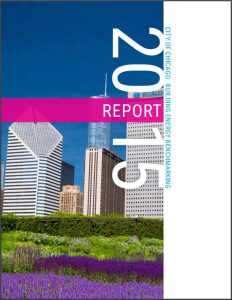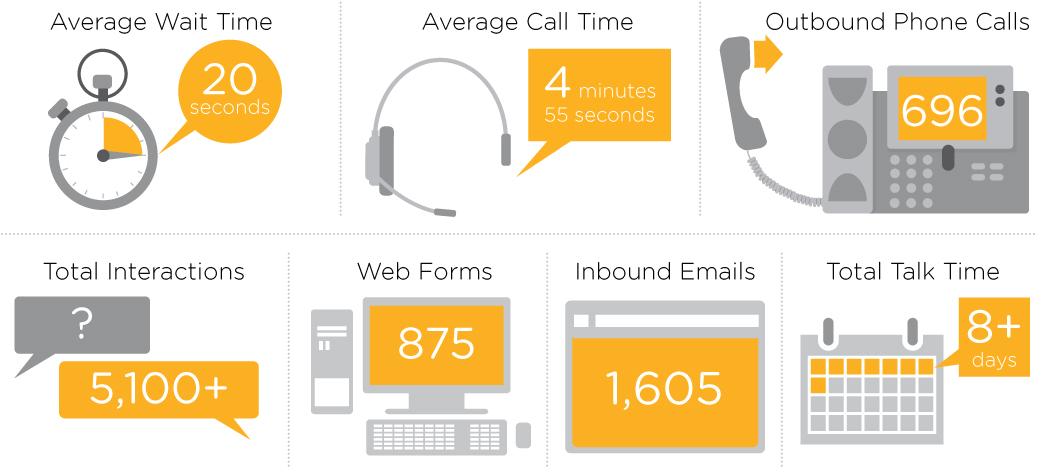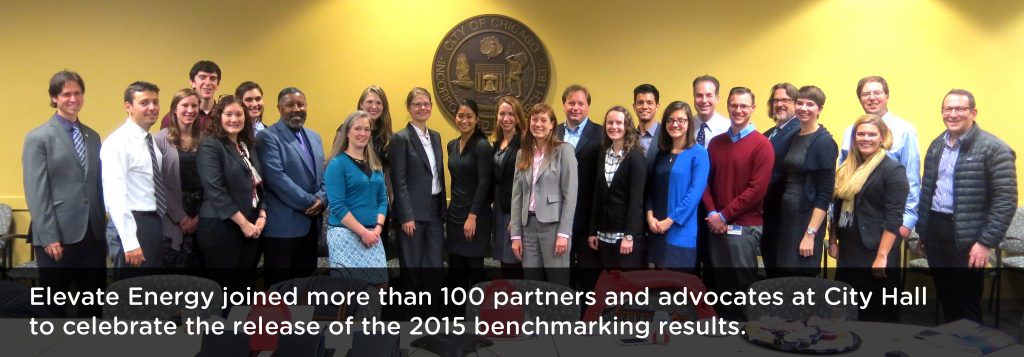Year Two of Chicago Energy Benchmarking Shows Potential Savings of $184 Million
Update!
Elevate Energy now offers benchmarking compliance services to help multifamily building owners or managers comply with Chicago’s Building Energy Use Benchmarking Ordinance. This year, residential buildings great than 50,000 square feet are required to measure, verify, and report energy use. Expert staff from Elevate Energy will help streamline this process for you, from identifying whether your building is required to comply to verifying and signing off on the data. Click here for more information on our services.
You can also email us at benchmarking@ElevateNP.org or call Maria Quiñones at 773-906-5140.
A 2015 report on the second year of Chicago’s energy benchmarking ordinance shows a potential savings of $184 million and a five-fold increase over the number of properties that reported energy use in 2014.
 The City of Chicago recently published the 2015 Building Energy Benchmarking Report which examines data collected during the second phase of implementation of the City’s Energy Benchmarking Ordinance.
The City of Chicago recently published the 2015 Building Energy Benchmarking Report which examines data collected during the second phase of implementation of the City’s Energy Benchmarking Ordinance.
The ordinance, enacted in 2013, requires commercial, municipal, and residential buildings to measure, verify, and report their energy use data to the City. This is the second year of a three year phase-in of the ordinance. Commercial and municipal buildings larger than 50,000 square feet and residential buildings larger than 250,000 square feet were required to comply in 2015.
The Opportunities Are Staggering
Building on momentum from 2014, more than 1,840 commercial, institutional, and residential properties reported their energy usage for the second year of the ordinance. This participation represents more than 600 million square feet of building space and accounts for 20 percent of Chicago’s city-wide energy use. All 77 community areas within Chicago had at least one property reporting in 2015.
The median ENERGY STAR score of the reporting properties was 58 out of 100. This indicates that many of Chicago’s reporting properties performed better than national median levels. Overall the properties showed strong levels of energy performance but there was a notable range. Offices, K-12 schools, retail buildings, and other properties generally reported scores higher than the national median, while multifamily buildings, lodging facilities, and healthcare properties generally reported scores lower than the national median.
If the energy performance of all properties improved to median and above-average levels for their building type, energy use could be reduced by 13 to 24 percent with a $100 to $184 million cost savings potential. The investment to achieve these reductions could result in up to 2,000 local jobs!
In addition, there was no statistical correlation between building age and energy performance. Meaning, older buildings can perform at the same or better energy performance levels than newer buildings.
From Outreach to Help Center: Elevate Energy’s Role
Elevate Energy is proud to have played a key role in the successful implementation of the ordinance over the past two years. In 2015, the Help Center handled more than five times the number of interactions compared to 2014, while also streamlining the exemption process, portfolio outreach, and data submission follow up processes. These efforts helped achieve a high overall compliance rate of nearly 85 percent, accounting for 92 percent of covered square footage.

Here’s how we helped:
- Compiled data from multiple sources to identify the buildings covered by the ordinance and those that own or manage them.
- Offered guidance materials and step by step instructions to help these owners comply. We also reached out to applicable building owners who hadn’t submitted data and who were not yet in compliance.
- Operated a full-time Help Center to provide personalized support to building owners and representatives via phone and email. In 2015, we also introduced web forms to better facilitate the exemption process and other common requests.
- Helped ensure data quality by conducting a rolling review of the data to identify incomplete submissions or potential errors. This included direct outreach and support for those who submitted incomplete or incorrect information.
- Analyzed data and supported efforts to communicate the results, including assistance with reviewing and writing the final report.
In 2015, the Help Center handled more than 5,100 interactions, bringing the total number to more than 6,000 interactions over the past two compliance years.

Why Benchmarking Matters
Benchmarking is the practice of measuring how much energy a building consumes compared to its baseline and comparing that energy performance against other buildings. It’s a valuable tool for building owners and other stakeholders, including program implementers and policy makers. For example, one finding in the 2015 report is that different building sectors draw their energy from a variety of fuel sources: 64 percent of the fuel mix for the multifamily sector is from natural gas but in office buildings, 68 percent of the fuel mix is from electricity. This finding presents an opportunity for program partnership among utilities to target more than one fuel source.
Also notable in this report is that this is the first time that multi-year data is available for properties that reported in both 2014 and 2015—analysis of these 212 properties shows a decrease in weather normalized site energy use over the two years. To drive awareness, transparency, and energy efficiency action, the City is also sharing building specific data starting with the buildings’ second year of compliance, as authorized by the ordinance. The new data set and accompanying map received more than 60 hits in the first hour they were released.
Many cities are implementing similar benchmarking ordinances to share important energy use data with multiple stakeholders. We’re excited about the opportunity to work with these cities and municipalities as they explore and adopt their own benchmarking efforts.
What’s up next for energy benchmarking in Chicago?
While the report has been released, work is not yet finished for the 2015 compliance year. Elevate Energy staff continue to assist building owners and representatives to submit and correct data, interpret their individual performance results, and provide guidance on the appropriate resources for how to reduce their energy use.
Planning is underway for the third phase of the ordinance this year when multifamily residential properties of 50,000 to 250,000 square feet will also be required to comply with the ordinance.
Read more about the findings of the first-year implementation in this report from 2014.
 This blog post is written by Lisa Roth, manager of Elevate Energy’s Program Support team. Lisa’s team operates the Benchmarking Help Center.
This blog post is written by Lisa Roth, manager of Elevate Energy’s Program Support team. Lisa’s team operates the Benchmarking Help Center.



